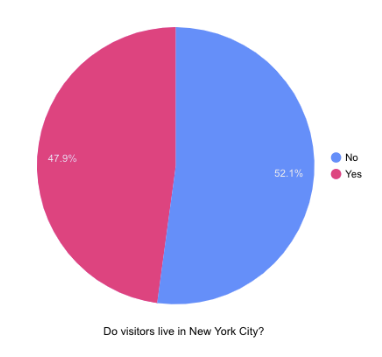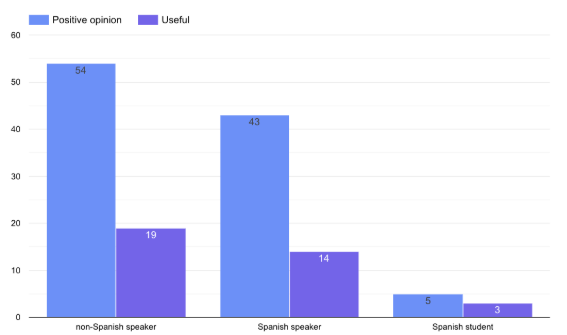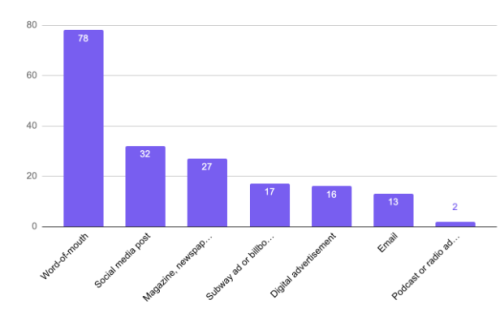Visitor Study: Frida Kahlo
In my last post, I posited that although we don’t have a CRM, we are gathering data in the ways we can to help inform our decisions. One recent example are the two evaluation projects completed by Pratt graduate students in the Museums and Digital Culture program last semester. I had eight students in the Audience Research & Evaluation course, so I split them into two groups of four for final projects. One team was responsible for completing a visitor study about ASK users and the other about visitors to Frida Kahlo. For this post, I’ll focus on the latter. The student project team for the Kahlo evaluation was Sydney Stewart, Megan Paqua, Grace Poole, and Caroline Baer. The results I’m sharing here are their interpretation of the data (reviewed by me) and their work (including the visuals).
The objective of the study, as defined by our institutional needs and finalized by project team, was to determine: who is coming to Frida Kahlo and will they return to the Museum? In addition, we wanted to know if the Spanish language materials were useful. The first part was really to help us check our assumption that Frida Kahlo might bring in a lot of first-time visitors. The second was to give us some insight on the ROI of the translation work we did for this exhibition, which was the most extensive we’ve ever done—ticketing pages, signs in the building, floor plan, and labels were all provided in both English and Spanish. While we’ve provided label copy in other languages in the past, we had yet to translate logistical information beyond the floor plan. We have a small team and none of our editors are native Spanish speakers. Best practice requires someone for translation as well as proofreading and layout review. Thankfully we have several fluent Spanish speakers (some of whom are native speakers) who helped in the review process and even translated our last minute signs. (Thank you Stephanie, Rachel, Jaime, and Allison!) Working with Eriksen Translations and our in-house powerhouse, we were able to get the translation completed, but it took a lot of extra time and resources.
We determined that the best approach to getting answers to our research objectives were interviews with Kahlo visitors. While we had visitor time and attention, we also asked about how they heard about the exhibition and how their experiences was. All eight students, myself, and Rachel Lewis (who conducted interviews in Spanish for us, thank you!) conducted interviews in the exhibition shop, which was exit point of the exhibition. We offered 10% shop coupons as an incentive to take the survey.
Results
We interviewed visitors during class time on four Thursday afternoons from about 3:30pm-5:30pm in March-April 2019. In total we completed 259 interviews. Below are the results, as written in the students’ final report (in quotes):
Who came to Frida Kahlo?
“Visitors came from a wide geographic area. Visitors to Frida Kahlo were almost evenly split between tourists and New York City residents. The majority of New York City residents were from Brooklyn, but the show also attracted visitors across the city. Overall, domestic visitors came from 26 states plus Puerto Rico, and international visitors came from 8 different countries.” Side note: the data is skewed since it only accounts for responses during a certain time window: Thursday afternoons. Responses would likely be different on different days. Weekends, for example, likely bring in more locals on their day off.

Visitorship was almost evenly split between locals and tourists, which may be accounted for by the fact that interviews took place Thursday afternoons only.
Did they use the Spanish language materials?
“Visitors responded positively to the inclusion of Spanish language materials, particularly the exhibition labels, whether or not they used them personally, and indicated that continued inclusion of bilingual materials would make them more likely to make a return visit to the museum.
Visitors frequently remarked on the relevance of the Spanish language materials for an exhibition about Frida Kahlo. Many visitors expressed an interest in expanding foreign language offerings in future exhibitions when appropriate, especially for exhibitions featuring artist from non-English speaking communities.”
How did they hear about the exhibition?
“35% of visitors reported learning about Frida Kahlo through word of mouth, although social media posts as well as reviews in major news publications were the next most effective at reaching visitors. On-site signage was also useful for attracting visitors who had not heard about the exhibition prior to their arrival at the museum.”
How was their experience? Will they come back to the Museum?
“No matter where visitors are coming from, Frida Kahlo was the primary motivation for visitors to come to the Brooklyn Museum, whether it was out of personal interest, to visit with a friend or family member, or based on a recommendation or advertisement. The majority of visitors expressed having positive opinions about the exhibition and their visit overall, even when they had complaints about other aspects of their experience.
Visitors had a clear interest in returning to the museum for special exhibitions, especially if the focus is on diverse communities or artists of color. Many visitors stated that they associated the Brooklyn Museum with this type of programming and were more positively disposed towards the institution as a result.”

For 71% of repeat visitors, “Frida Kahlo” specifically and special exhibitions in general are the reason to return to the Museum.
What would visitors like to see more of at the Museum?
“When asked what they would like to see more of at the museum, 10.71% of visitors responded with requests for more activities designed for children. These visitors were overwhelmingly returning visitors, indicating that this is a current gap in the Museum’s programming within the exhibition space.”
Learnings
This evaluation confirmed some of what we already knew:
- Special exhibitions are a big draw for first time and repeat visitors alike.
- Word-of-mouth is important, though it’s sometimes tough to parse out the nuances of this answer. While some people genuinely couldn’t remember exactly where they heard about it, for others there might be more to the story. For example, their friend told them about it either through social media or because that friend saw it on social media. So does that count as word-of-mouth or social media? Or both? More to play with here to get better data to help our marketing team.
And gave us some new insights:
- The majority of visitors felt that the Spanish materials contributed positively to their experience whether they used them or not.
- There’s a desire for more activities for children specifically in the exhibition galleries. As reported: “Of the individuals who responded to what they would like to see more of at the museum, 10.71% indicated a desire for more kid-friendly activities. The kid-friendly advocating visitors are also primarily returning visitors (88.9% who desire kid friendly activities).”

Those interviewed felt that the Spanish materials were positive and useful whether they speak Spanish or not.
The results of this evaluation have been really useful as we think about planning our upcoming exhibitions. In particular the usefulness of languages has come up a few times as we plan for our Pierre Cardin: Future Fashion exhibition opening next month. Do we translate to French, the designer’s native tongue? Ultimately we decided not to go that route, but mostly because we don’t think we’ll have high attendance of Francophiles (since Cardin has his own museum in Paris).
In addition to providing some good information about visitors to Frida Kahlo, the evaluation also gave us good practice as crafting questions and things to think about in terms of how to tease out nuances of how people hear about the exhibitions. As always, it’s a work-in-progress.

Sara Devine joined the Brooklyn Museum as Manager of Interpretive Materials in 2011 and is now Director of Visitor Experience & Engagement. A vocal visitor advocate, her expertise lies in crafting accessible and engaging visitor experiences and reaching audiences across platforms. She works with curators, designers, educators, technologists, and editors on all aspects of visitor experience and engagement. Sara is also a visiting assistant professor and curriculum coordinator at Pratt Institute’s School of Information for their graduate program in Museums and Digital Culture. She was previously Senior Content Developer and Project Manager at Hilferty, a museum planning and design firm in Ohio, where she developed comprehensive interpretive master plans and exhibitions for a wide variety of museums. She has also worked at Assistant Curator, Special Exhibition at Thomas Jefferson’s Monticello and as a Curatorial Assistant at the Smithsonian Museum of Natural History.





Start the conversation